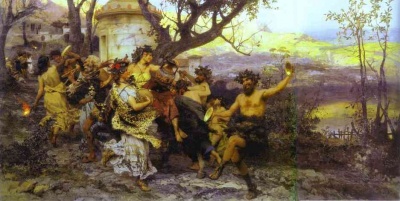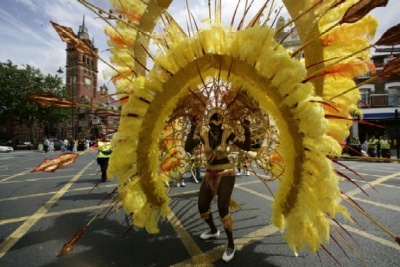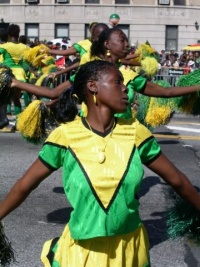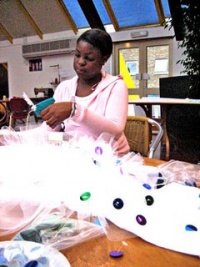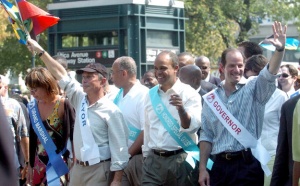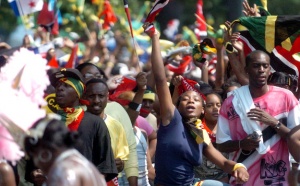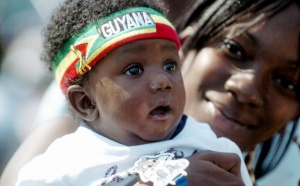Carnival
From Seminar 2: The Peopling of New York City
Contents |
Overview
Carnival is a celebration found around the world. In New York City, it is an extremely vibrant event that is celebrated every year. Carrying over three million people with many out-of-state residents, Carnival is celebrated with people wearing elaborate designs followed by the sounds of steel band march throughout the streets of Eastern Parkway. This brings together people of all kinds in one place. This lively festival is no doubt a celebration of life and a tool for self-expression because in many ways, the festival is a also a celebration of the growing Caribbean immigrant community that is in Flatbush section of Brooklyn. It is no wonder then how much this festivity is impacting the economy, politics, and cultures of New York City.
This project looks at how Carnival allows for the creation of a national identity and the significance of the costumes and fashion in invoking the feeling of being back home as well as their confirmation for each person’s distinct and unique characters. All of which were accomplished through literature analysis, as well as fieldwork, which includes interviews and participant observation.
Below is a video of the Caribbean Festival taken at City College of New York:
The History of Carnival
European Influences
According to some scholars, the history of Carnival predates Christianity. It originated as a pagan rite celebrating diverse occasions such as the advent of the seasons, fertility of crops, anniversaries of deities (Donnie, F. 1992). One of the earliest manifestations of these rites was that of Osiris in ancient Egypt, which celebrated the renewal of life brought about by the flooding of the Nile River. But it was not until the reign of the Roman Empire that carnival started to become more prevalent, with the festivals of Bacchanalia, a mystic festival for the Roman god Bacchus; Saturnalia, a festival for the god Saturn; and Lupercalia, a festival to cleanse and purify.
During the Middle Ages, Carnival, was celebrated with considerably more pageantry, moved westward along the North of the Mediterranean coast, infecting countries such as Spain, Portugal, Germany, and France. It was during this time that the festival was brought under the influence of the Roman Catholic Church. They began to associate carnival with Lent, as it was tradition to hold wild costume festivals right before the first day of Lent. Since Catholics are not allowed to eat meat during Lent, the festivals were called carnevale, which meant, “to put away the meat”. Not long after, when the Europeans started to take control of other countries such as the Americas and other parts of the world, the tradition of celebrating carnival was also brought along with them.
African Influences
Colonialism in Africa brought along a lot of African influences into this festival. The colonists brought with them the idea of circling the villages, which was believed to bring good luck and ward against evil, anger, and sadness. In addition, they brought with them the use of natural elements in the making of costumes. Feathers, grasses, bones, and shells are some of these natural elements.
During the slave trade, slaves brought over traditions of carnival. Carnival in the Caribbean comes in a number of variations and is celebrated for an equally number of purposes. In Barbados, it is known as crop over, and was originally celebrated by the slaves, which was encouraged by their masters to mark the end of the harvesting period. In Guyana, it is referred to as Mashramani, or Mash. It is very ritualistic, but today includes more festive aspects of contemporary Carnival and is emerging in a more traditional form.
Elite of West Indian style Carnival is Trinidad, celebrated the week before lent. Mas, short of masquerade, is the name given to the competitive aspect of the Carnival. Because Trinidad has a long history of forced labor, Carnival was used to express individuality as well as a way to make fun of slave masters and other political figures’ behaviors behind masks. Mas progressed in Trinidad following the Second World War. Originally celebrated by the people who are abused and oppressed, it has advanced from wild, roving bands of rowdy revelers in costumes that are made without care to an organized art festival with beautifully crafted and intricately designed costumed bands and individuals.
Carnival in America originated in the French quarters of New Orleans, Mardi Gras. But it was not until West Indians began settling in New York City, were their any attempt to celebrate Carnival in the city. It was celebrated first indoors in Harlem but later moved on to the streets of Brooklyn, becoming one of the worlds’ largest ethnic parade, drawing a crowd of over two million per year (Allen, R. 1999).
Carnival Today
The Labor Day extravaganza has been drawing thousands to Brooklyn for many years, but as the deadline loomed, excitement is in the air. Headlines in the newspapers notify the community about this event. “I had to take time off work. I’m getting about 4 hours of sleep at night” (Daily News 1995). Similar frenzied activity takes place around the clock in many small shops and private homes spread through Crown Heights and Flatbush. Each is home to a mas – or masquerade camp, where teamwork and organization are crucial to creating an award-winning production. Many hopes to win top prizes when its band of musicians and marchers walks proudly down Eastern Parkway. Others want to gain bragging rights for the year. And still others want to display the pride they have in their traditions. This prize is given based on the originality, beauty, and performance of the costumes.
In order to put a carnival band together, preparation begins months in advance. It takes many weeks of welding; sewing; gluing; applying feathers, sequins, foil papers, glitter, and lots of creativity, energy, and patience. The first step is to come up with a theme or overall concept for the band and to develop costume illustrations for each section of dancers; this is the job of the designer. Costumes are then sewn, decorated, and fitted to each individual dancer by the wirebender and the tailor. All this takes place in mas camps. Each camp will produce numerous, sometimes hundreds of costumes embodying the camp theme.
Recently, however, interviews with a second-generation West Indian woman from Flatbush revealed that some mas camps have stopped making their costumes due to the overwhelming number of people, resources, and time dedicated to this event. “There just isn’t enough time to do everything on top of all the work”. When asked whether this has made her appreciate her culture less, she replied, “Not at all. The amount of time missed in the making of costumes is used to prepare the dances of her people and learning and teaching others how to play in the steel band.” So where did they get the costumes then? Turns out, they are importing them from Trinidad, their home. Throughout the interview, calypso music and feet dancing to the music can be heard and felt all around the building. This vibrant community does not seem to want to stop.
Observations revealed the mass numbers of steel pans in the basement as well as the number of kids being taught to dance the dances of their home and play the steel pans. This dedication of the emphasis on the performances and learning rather than on the making of costumes seems to work for this mas camp, as they are prized winner for the past twenty years in Carnival.
So popular is Carnival, that it is drawing a lot of our nation’s leaders to become active in this event. Carnival is now becoming very politically charged, as many leaders are investing a lot of time and resource during carnival in order to advance themselves in campaigns and votes. In addition, all along the parae route, community organizers hand out flyers to passerby regarding recent political acts urging people to take part in marches, protests, etc.
The Future
Some claim that the Carnival has become New York's largest cultural celebration, drawing crowds estimated between 1 and 3 million each year. The Carnival has even been used to promote tourism in New York. Visitors come from as far as Canada and the United Kingdom, while others travel from New Jersey and Connecticut. A 2003 study found that the total economic impact of the Carnival was $154,800,000, though organizers claim the figure is closer to $200 million. The success of the Carnival has inspired imitators in other cities such as Miami and Boston.
Aside from its economic impact, the Carnival is an assertion of pan-Caribbean culture, bringing together people from different island nations under one area code, and demonstrating to the rest of the world the power and vibrancy of the peoples of the Caribbean. Politicians from within and outside of the Caribbean community are keen to make their presence felt in Brooklyn on Labor Day, a day to see and to be seen.
My interview with one of the original founds of Sesame Flyers International have made me see the great impact local organizations are doing to revitalize the pan-Caribbean culture. It is an organization that pursues its mission to promote and encourage the cultural enhancement of young people in the community. Founded in 1983, it provides education services to about 2,000 children and adults. One of the original founders, Cecil McEwin, notes that it is a place that babysits children when their parents work and connect their cultural ties to their new world as most are second generation immigrants. He says that it is important for the newcomer’s children to understand their parent’s heritage and to keep it alive. “Kids today needs to know where they are coming from, it’s important because it gives them a sense of self.”
Similary, Bevan Springer of Caribbeat Magazine mentioned the importance of the Sesame Flyer motto of loving a kid today and everyday. In addition to enjoying a stable environment where homework can be done, children can learn to play steel pans, write calypso tunes or do the shango dance at the centers (Springer, B. 2000).
Conclusion
Carnival has become integrated from one place to another throughout the course of history. This movement of culture is responsible for the vast number of Caribbean-like carnival found in United States. Carnival is not just about having having fun, dressing up, and dancing to good music, it is a reminder of its origin as a struggle of marginalized people that wanted freedom, equality, and a release. These common themes are found throughout the course of history: slavery, post-emancipation, and even today. They are the imaginary ties that allow for the bonding between diasporic communities and their home. Technological advances such as airplanes, telephones, and internet allows for this fueling of a pan-Caribbean identity. West Indian Carnival in New York City becomes one way that reinforces this identity because people from the Caribbeans and people that live in New York are able to bring their own style and taste of their home to the Carnival. The overwhelming colors, musics, and places that people are coming from all allow the creation of this diasporic identity through expression of the self.
The West Indian Carnival in Brooklyn, New York offers a glimpse into the dynamic ways of self-expression and exploration, a tool to seek out our roots, a tool to develop new forms of looking at the world and its cultures, and finally, a tool to unite the world, to discover what we all have in common, and to celebrate what makes us different. The power and creativity that underlies these art forms is very great indeed.
Works Cited
Allen, Ray. 1999. J’ouvert in Brooklyn Carnival: Revitalizing steel pan and ole mas traditions. Western Folklore, 58: 14
Edmondson, Belinda. 1994. Race, Tradition, and the Construction of the Caribbean Aesthetic. New Literary History 25(1): 109-120.
Esiaba Irobi. 2007. What They Came with: Carnival and he Persistence of African Performance Aesthetics in the Diaspora. Journal of Black Studies, 37 (6): 896-913.
Foner, Nancy,ed. 2001. Islands in the City: West Indian Migration to New York. Berkeley: University of California Press.
Forde, F Donnie. West Indian American Carnival: the Next 25 Years. Diss. Carribbean/American Media Studies, 1992. Brooklyn, N.Y.: CAMS Inc.
Manning, Frank. 1990. Oversees Caribbean Carnivals: The Art and Politics of a Transnational Celebration. Plantation Society in the Americas (no volume): 47-62.
Nunley, John W. 1989. Caribbean Festival Arts: Each and Every Bit of Difference. African Arts 22(3): 68-88
Riggio, Milla. 1998. Resistance and Identity: Carnival in Trinidad and Tobago. The Drama Review 42: 7-23.
Scher, Philip W. 2002. Preservation, Carnival, and the State in Trinidad. Anthropological Quarterly, 75: 453-484.
Springer, Bevan. More Than Mas: Sesame Flyers Int'L Teaches Culture. Carribeat Magazine Aug.-Sept. 2000: 24.
Willimas, Laura, and Corky Siemaszko. Making Carnvial Day Shine. Daily News 31 Aug. 1995.
http://www.abcgallery.com/S/semiradsky/semiradsky9.html
http://mayor.newham.gov.uk/Pictures/picture/Carnival+costume/337
http://www.nydailynews.com/news/galleries/west_indies_parade/west_indies_parade.html
http://padartscarnival07.blogspot.com/
